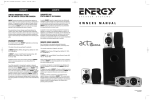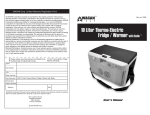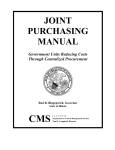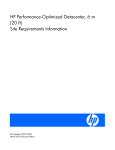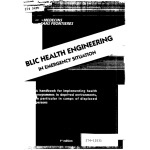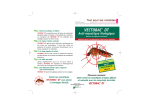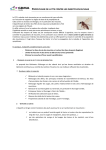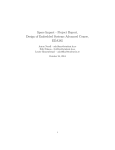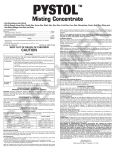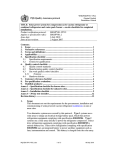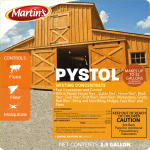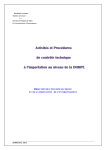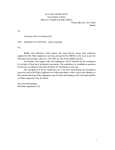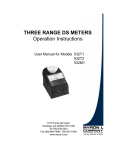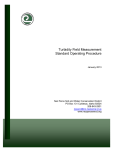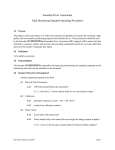Download how-to manual for visual and physical monitoring in the field
Transcript
HOW-TO MANUAL FOR VISUAL AND PHYSICAL MONITORING IN THE FIELD Prepared by Mosquito and Vector Control Association of California URS Corporation October 3, 2011 TABLE OF CONTENTS Section 1 Introduction..................................................................................................................... 1-1 Section 2 Before Going Into the Field............................................................................................ 2-1 2.1 2.2 2.3 Section 3 Monitoring In the Field ................................................................................................... 3-1 3.1 3.2 3.3 3.4 Section 4 How to make visual observations ............................................................ 3-1 How to collect physical field measurements ........................................... 3-1 How to collect grab samples for the lab................................................... 3-4 How to report problems with monitoring ................................................ 3-6 Record Keeping .............................................................................................................. 4-1 4.1 4.2 Section 5 How to prepare for field monitoring ........................................................ 2-1 How to calibrate the field instrument....................................................... 2-4 2.2.1 How to calibrate for pH ............................................................... 2-4 2.2.2 How to calibrate for DO .............................................................. 2-5 2.2.3 How to calibrate for EC ............................................................... 2-6 2.2.4 How to calibrate for turbidity ...................................................... 2-7 How maintain the field instrument .......................................................... 2-8 Record keeping requirements .................................................................. 4-1 How to record monitoring results ............................................................ 4-1 Point of Contact .............................................................................................................. 5-1 Figures Figure 1. YSI 556 Multiprobe System Figure 2. Features of the probe module Figure 3. LaMotte 2020w turbidimeter \\1575SR-PRJ01\PROJECTS\MVCAC_NPDES_26817690\5-DELIVERABLES\HOW-TO MANUAL\MVCAC_HOW-TO-MANUAL_3OCTOBER2011.DOC\\3-OCT-11 i SECTIONONE 1. Section 1 ONE Introduction Introduction SECTION 1 INTRODUCTION This How-To Manual is to be used by Mosquito Vector Control Association of California (MVCAC) Member Agency field personnel during training and monitoring. Monitoring shall include both visual observations and measurements of physical parameters in the field. For a larvicide application event, monitoring shall be conducted before and immediately after the event, and within a week after the entire application project. For an adulticide application event, monitoring shall be conducted before and immediately after the event. Visual observations of the monitoring area, appearance of the water body, and weather conditions shall be described and documented. Physical measurements will be taken of water temperature, electrical conductivity (EC), dissolved oxygen (DO), pH, and turbidity. Turbidity may be measured in the field or by lab analysis using a water sample. The results of these monitoring activities will be recorded on a standardized field log. Monitoring instructions are described in layman’s terms in this Manual. This Manual is not intended to replace the MVCAC Monitoring Plan, MVCAC Quality Assurance Project Plan (QAPP), field instrument operations manuals, or any standard operating procedures. Member Agencies are responsible for the health and safety of their field personnel. This Manual does not specify safety precautions (e.g., use of personal protective equipment, traffic cones, etc.) that should be taken during the activities described herein. \\1575SR-PRJ01\PROJECTS\MVCAC_NPDES_26817690\5-DELIVERABLES\HOW-TO MANUAL\MVCAC_HOW-TO-MANUAL_3OCTOBER2011.DOC\\3-OCT-11 1-1 SECTIONTWO 2. Section 2 TWO Before Going Into the Field Before Going Into the Field SECTION 2 BEFORE GOING INTO THE FIELD 2.1 HOW TO PREPARE FOR FIELD MONITORING 1. Assemble a field team of at least two people, with at least one trained person. The trained person should already be familiar with this Manual. 2. Calibrate and maintain field instruments in accordance with the manufacturer’s specifications. Instructions for calibrating and maintaining are briefly described in this Manual. Note: This Manual uses the YSI 556 MPS (see Figures 1 and 2) as an example field instrument for measuring temperature, EC, DO, and pH. The YSI 556 MPS does not have the ability to measure turbidity. The LaMotte 2020w (see Figure 3) is used an example field instrument for measuring turbidity. MVCAC may consider using other hand-held instruments outfitted with all necessary sensors/probes, including the YSI 6136 turbidity sensor. If a different instrument is used, then refer to that instrument’s user manual. 3. Pack the following supplies and equipment: a. Directions to the monitoring locations, maps, site photos, and/or a GPS unit, as necessary. Monitoring locations should be selected before field personnel are deployed. b. Field instruments (e.g., YSI 556 MPS and LaMotte 2020w) that have been calibrated and are in good working order c. Pens and permanent markers d. Flat writing surface (such as a clipboard or binder) e. Monitoring Log Sheets printed on waterproof (e.g., Rite-n-Rain) paper, if available. Fill out as much of the “Pesticide Application Information” and “Monitoring Information” (except the time) sections as possible before going out into the field. Note: A blank Monitoring Log Sheet is provided at the end of this Manual. The information that the field team needs to gather and record during visual observations and field measurements is listed on the Monitoring Log Sheet. f. Appropriate health and safety gear in accordance with Member Agency protocol. These may include: i. Disposable latex gloves (or equivalent) ii. Waders or rubber boots iii. Reflective safety vests iv. Road cones v. Emergency contact information g. Sampling equipment if any field parameters (e.g., turbidity) will be collected for lab analysis \\1575SR-PRJ01\PROJECTS\MVCAC_NPDES_26817690\5-DELIVERABLES\HOW-TO MANUAL\MVCAC_HOW-TO-MANUAL_3OCTOBER2011.DOC\\3-OCT-11 2-1 SECTIONTWO Before Going Into the Field i. Grab sample containers provided by lab ii. Sample labels Note: Labels should include the site name or ID (same as the location given on the Monitoring Log Sheet), date, sample time, and field personnel’s initials. Use 24-hour military time for the sample time; round to the nearest 10 minutes. For example: a sample collected at 09:52 would have the sample time on the label and Chain of Custody (COC) form rounded off to 09:50; a sample collected at 09:57 would be rounded up to 10:00; 09:55 would also be rounded up to 10:00. Use the following format for the date: mm/dd/yy. iii. Clear tape iv. Cooler for sample storage and shipping v. Ice (or blue icepack, if provided by lab) vi. 5-gallon carboy of clear water (i.e., tap water), or equivalent vii. Chain of Custody (COC) forms Note: A blank COC form is provided at the end of this Manual. viii. Pole sampler with bungee cord Display Unit Probe Module Source: YSI Incorporated 2011. http://www.ysi.com/productsdetail.php?556MPS-21 Figure 1. YSI 556 Multiprobe System \\1575SR-PRJ01\PROJECTS\MVCAC_NPDES_26817690\5-DELIVERABLES\HOW-TO MANUAL\MVCAC_HOW-TO-MANUAL_3OCTOBER2011.DOC\\3-OCT-11 2-2 SECTIONTWO Before Going Into the Field Source: YSI 556 MPS Operations Manual Figure 2. Features of the YSI 556 probe module Source: LaMotte Company 2011. http://lamotte.com/component/option,com_pages/lang,en/mid,/page,63/task,item Figure 3. LaMotte 2020w turbidimeter \\1575SR-PRJ01\PROJECTS\MVCAC_NPDES_26817690\5-DELIVERABLES\HOW-TO MANUAL\MVCAC_HOW-TO-MANUAL_3OCTOBER2011.DOC\\3-OCT-11 2-3 SECTIONTWO 2.2 Before Going Into the Field HOW TO CALIBRATE THE FIELD INSTRUMENT Calibrate each of the field instrument’s sensors/probes according to the manufacturer’s specifications. They are summarized in the table below for YSI 556 MPS and LaMotte 2020w. Brief step-by-step instructions for these instruments are given after the summary table. Sensor/Probe Activity Frequency pH glass electrode (YSI 556 MPS) 3 Point calibration at pH 4, 7, and 10 Within 24 hours before sampling DO sensor (YSI 556 MPS) H2O Saturated air calibration (%O2) at default 760mm Hg Before every measurement at field site EC and temperature probe (YSI 556 MPS) EC calibration to 1413 µS/cm, no calibration for temperature Within 24 hours before sampling Turbidimeter (LaMotte 2020w) Calibration blank; meter zeroed and calibrated to 100 NTU Within 24 hours before sampling 2.2.1 How to calibrate for pH 1. Make sure the sensor and transport/calibration cup are clean and dry. 2. On the display unit, go to the main menu (press ‘Esc’ key), and select ‘Calibrate’, ‘pH’, then ‘3 point’. 3. For the first calibration point at pH 7: a. Place buffer solution in the cup for the first point of calibration (30 mL Fisher Scientific Buffer Solution for pH 7). b. Place the sensor into the solution. Move the sensor around to remove any bubbles. c. Using the temperature-pH conversion chart on the buffer container, look up the pH value of the solution at the current temperature. Type in this pH value and press enter. d. Wait one minute for temperature and pH to stabilize. e. When the temperature and pH values on the display screen have stabilized, press enter to complete the first calibration point. Note: The temperature and EC values can be found as shown on the example display screen below: \\1575SR-PRJ01\PROJECTS\MVCAC_NPDES_26817690\5-DELIVERABLES\HOW-TO MANUAL\MVCAC_HOW-TO-MANUAL_3OCTOBER2011.DOC\\3-OCT-11 2-4 SECTIONTWO Before Going Into the Field f. Press enter again to return to the pH entry screen or the pH calibration menu. g. Rinse the probe module and sensor in clear water and dry. 4. For the second calibration point at pH 4, repeat step 3 (parts a through g). 5. For the third calibration point at pH 10, repeat step 3 (parts a through g). 6. Press enter again to accept this 3 point calibration and return to the calibration menu. 2.2.2 How to calibrate for DO 1. Make sure the calibration is performed in a location where the air temperature is somewhat close to the water temperature. If the air is too hot, move into the shade. If the air is too cool, move into the sun. 2. Make sure the sensor is clean. 3. Make sure a little bit (about 1/8 inch) of clear water is at the bottom of the transport/calibration cup. 4. Lightly attach the cup to the probe module. 5. On the display unit, go to the main menu (press ‘Esc’ key), and select ‘Calibrate’, ‘DO’, then ‘DO %’. 6. Type in “760” mmHg for the barometric pressure and press enter. 7. Wait 10 minutes for temperature and pressure to stabilize. 8. When the DO value on the display screen has stabilized, press enter to complete calibration. Note: The DO value can be found as shown on the example display screen below: \\1575SR-PRJ01\PROJECTS\MVCAC_NPDES_26817690\5-DELIVERABLES\HOW-TO MANUAL\MVCAC_HOW-TO-MANUAL_3OCTOBER2011.DOC\\3-OCT-11 2-5 SECTIONTWO Before Going Into the Field 9. Press enter again to accept this calibration and return to the calibration menu. 10. Rinse the probe module and sensor in clear water and dry. 2.2.3 How to calibrate for EC 1. Make sure the sensor and transport/calibration cup are clean and dry. 2. On the display unit, go to the main menu (press ‘Esc’ key), and select ‘Calibrate’, ‘Conductivity’, then ‘Specific Conductance’. 3. Place standard solution (55 mL Oaklon) in the cup. 4. Place the sensor into the solution. Move the sensor around to remove any bubbles. 5. Type in “1.413” mS/cm for the conductivity of the standard solution and press enter. 6. Wait one minute for temperature and specific conductance to stabilize. 7. When the temperature and EC values on the display screen have stabilized, press enter to complete calibration. Note: The temperature and EC values can be found as shown on the example display screen below: \\1575SR-PRJ01\PROJECTS\MVCAC_NPDES_26817690\5-DELIVERABLES\HOW-TO MANUAL\MVCAC_HOW-TO-MANUAL_3OCTOBER2011.DOC\\3-OCT-11 2-6 SECTIONTWO Before Going Into the Field 8. Press enter again to accept this calibration and return to the calibration menu. 9. Rinse the probe module and sensor in clear water and dry. 2.2.4 How to calibrate for turbidity 1. Make sure that the light chamber and sample tube (code 0290) are clean and dry. 2. From the Main Menu on the display, select ‘Measure’, then ‘Turbidity – With Blank’. 3. Prepare and scan the blank: a. Rinse the inside of a clean tube three times with clear water. b. Fill the tube with clear water. Make sure there are no bubbles. c. Cap and dry the tube. d. Insert the tube into the light chamber. Make sure the line on the tube matches the line on the meter. Close the lid. e. Press the ‘ENTER’ button to scan the blank. 4. Prepare and scan the standard (100 NTU): a. Rinse the tube three times with standard water. b. Fill the tube with standard water. Make sure there are no bubbles. c. Cap and dry the tube. d. Insert the tube into the light chamber. Make sure the line on the tube matches the line on the meter. Close the lid. e. Press the ‘ENTER’ button to scan the standard. f. Press the down arrow button to select ‘Calibrate’. g. Press the down and up arrow buttons to select the standard value of 100 NTU. h. Press the ‘ENTER’ button to select ‘Calibrate’. \\1575SR-PRJ01\PROJECTS\MVCAC_NPDES_26817690\5-DELIVERABLES\HOW-TO MANUAL\MVCAC_HOW-TO-MANUAL_3OCTOBER2011.DOC\\3-OCT-11 2-7 SECTIONTWO Before Going Into the Field 5. Select ‘Set Calibration’ to save the calibration. 6. Rinse the tube in clear water and dry. 2.3 HOW MAINTAIN THE FIELD INSTRUMENT All field equipment, including containers and instruments, must be washed off in the office before and after every use. Equipment is also rinsed off with sample water at each field site before samples are collected. Maintain each of the field instrument’s sensors/probes according to the manufacturer’s specifications. They are summarized in the table below for YSI 556 MPS and LaMotte 2020w: Sensor/Probe pH glass electrode (YSI 556 MPS) Activity Clean glass bulb and visually inspect Frequency Before calibration and within 24 hours before sampling DO sensor (YSI 556 MPS) Change membrane and KCl solution Every 30 days EC and temperature probe (YSI 556 MPS) Clean electrodes Before calibration and within 24 hours before sampling Turbidimeter (LaMotte 2020w) Clean light chamber and sample tube, and visually inspect Before calibration and within 24 hours before sampling \\1575SR-PRJ01\PROJECTS\MVCAC_NPDES_26817690\5-DELIVERABLES\HOW-TO MANUAL\MVCAC_HOW-TO-MANUAL_3OCTOBER2011.DOC\\3-OCT-11 2-8 SECTIONTHREE 3. Section 3 THREE Monitoring In the Field Monitoring In the Field SECTION 3 MONITORING IN THE FIELD 3.1 HOW TO MAKE VISUAL OBSERVATIONS 1. All Member Agencies will participate in visual observations. 2. For both larvicide and adulticide monitoring, visual observations shall be conducted for application of each active ingredient at 10% of all application events or six application events, whichever is greater. a. For larvicides, conduct visual observations three times per application event: i. Background (24 hours prior to application) ii. Event (within 24 hours after application) iii. Post-event (within 1 week after project completion) b. For adulticides, conduct visual observations two times per application event: i. Background (24 hours prior to application) ii. Event (within 24 hours after application) 3. On a new Monitoring Log Sheet, fill out the “Pesticide Application Information” and “Monitoring Information” sections at the top of the sheet if they haven’t been completed already. If field measurements will be made for the same location on the same day and time, then use the same Monitoring Log Sheet for that set of field measurements. 4. Make visual observations of the weather (cloudiness, precipitation, wind, temperature) and water conditions (color, clarity, etc.) from the edge of the water body. Do not wade into the water to make visual observations. 5. Check the appropriate boxes on the Monitoring Log Sheet under the “Visual Observation” section. 3.2 HOW TO COLLECT PHYSICAL FIELD MEASUREMENTS 1. Select Member Agencies will collect physical field measurements for larvicide applications. MVCAC will collect physical field measurements for adulticide applications. 2. For both larvicide and adulticide monitoring, physical measurements will be recorded for up to six application events per environmental setting (urban, agricultural, or wetland). a. For larvicides, conduct field measurements three times per application event: i. Background (24 hours prior to application) ii. Event (within 24 hours after application) iii. Post-event (within 1 week after project completion) \\1575SR-PRJ01\PROJECTS\MVCAC_NPDES_26817690\5-DELIVERABLES\HOW-TO MANUAL\MVCAC_HOW-TO-MANUAL_3OCTOBER2011.DOC\\3-OCT-11 3-1 SECTIONTHREE Monitoring In the Field b. For adulticides, conduct field measurements two times per application event: i. Background (24 hours prior to application) ii. Event (within 24 hours after application) 3. On a new Monitoring Log Sheet, fill out the “Pesticide Application Information” and “Monitoring Information” sections at the top of the sheet if they haven’t been completed already. If visual observations have already been made for the same location on the same day and time, then use the same Monitoring Log Sheet for that set of visual observations. 4. Based on the water body conditions, figure out how the measurement will be taken: a. If the water body is narrow (for example, middle of stream is within arm’s reach) and shallow, the measurement should be taken from the bank. b. If the water body is wide and can be safely waded (for example, the flow is slow), the measurement should be taken by wading into the middle of the water body. Put on waders or rubber boots if following this method. c. If the water body is wide and cannot be safely waded (for example, the flow is too fast or strong to stand up in), the measurement should be taken by using a pole sampler from the safety of the bank or bridge. If sampling from a bridge, the measurement should be taken from the upstream side of the bridge. 5. Put on new gloves. 6. Set up the field instrument by attaching the probe module to the base of the display unit. Turn the field instrument on. If using a field turbidimeter, set up the turbidimeter on a sturdy surface on the bank and turn on. 7. Make sure that the instrument has been calibrated and maintained appropriately. Note: The DO sensor must be calibrated at every field site before DO measurement. Instructions for calibrating the DO sensor are given in Section 2.2.2. 8. Make sure that the units in which the instrument is measuring the field parameters are as shown in the table below: Field parameter Units Temperature degrees Fahrenheit (°F) EC microsiemens per centimeter (µS/cm), which is same as micromhos per centimeter (µmhos/cm) DO milligrams per liter (mg/L) pH pH units Turbidity (if measured by field instrument) nephelometric turbidity unit (NTU) 9. Attach the probe sensor guard to the probe module before placing the probe module in the water body or sample container. (If using a turbidimeter, this step does not apply.) \\1575SR-PRJ01\PROJECTS\MVCAC_NPDES_26817690\5-DELIVERABLES\HOW-TO MANUAL\MVCAC_HOW-TO-MANUAL_3OCTOBER2011.DOC\\3-OCT-11 3-2 SECTIONTHREE Monitoring In the Field 10. If it is safe and if water is deep enough, face upstream and place the probe of the field instrument directly into the middle of the waterway or flowpath of the water body. (If using a turbidimeter, this step does not apply.) a. If monitoring for a larvicide application, place the probe at a depth of 3 feet, if possible (or mid-depth if water is shallow). b. If monitoring for an adulticide application, place the probe immediately below the water surface. 11. Otherwise for shallow waters, face upstream and fill a clean grab sample container with water by holding the container in the middle of the flowpath (facing the container opening upstream and ideally upwind). (If using a turbidimeter, this step does not apply.) a. If monitoring for a larvicide application, the grab sample should be collected at a mid-depth. If possible, the grab sample container should be uncapped, filled, and recapped while underwater. b. If monitoring for an adulticide application, the grab sample should be collected immediately below the water surface. c. Place the probe in the container, or if using a turbidimeter, place the tube in the light chamber. 12. If using a turbidimeter, prepare a sample tube to bring back to the instrument at the bank for measurement. a. Remove the cap of a clean sample tube (tube number = code 0290). b. Rinse the tube three times in the water body. c. Fill the sample tube with water by holding the tube in the middle of the flowpath (facing the container opening upstream and ideally upwind). i. If sampling for larvicides, dip the opening of the container 3 feet below the surface (or mid-depth if water is shallow). If possible, the sample tube should be uncapped, filled, and recapped while underwater. ii. If sampling for adulticides, dip the opening of the container immediately below the water surface. d. Cap and dry the tube. Make sure there are no bubbles. e. Insert the tube into the light chamber. Make sure the line on the tube matches the line on the meter. Close the lid and scan the sample. 13. Allow the instrument readings to stabilize before recording the results on the Monitoring Log Sheet. If using a turbidimeter, the turbidity reading will appear instantly when scanned. Record the instrument model (e.g., YSI 556 MSP, LaMotte 2020w) and/or unit number on the Monitoring Log Sheet. Note: If flow in the water body is low, or if measuring in the container, stir the probe so that the DO sensor will stabilize. 14. Record the results for temperature, EC, DO, pH, and turbidity (if measured by field instrument) on the Monitoring Log Sheet under the “Field Measurement” section. \\1575SR-PRJ01\PROJECTS\MVCAC_NPDES_26817690\5-DELIVERABLES\HOW-TO MANUAL\MVCAC_HOW-TO-MANUAL_3OCTOBER2011.DOC\\3-OCT-11 3-3 SECTIONTHREE Monitoring In the Field 15. Turn off the field instrument and detach the probe module. Rinse the probe with clear water before placing the instrument back in its case. 3.3 HOW TO COLLECT GRAB SAMPLES FOR THE LAB If the field instrument does not measure turbidity or other required physical parameters, then grab samples will need to be collected and sent to Caltest Analytical Laboratory. Grab samples should be collected at the same time as field measurements. 1. Put on new gloves. 2. Complete a label for one sample container using a permanent marker. The label should include the site name or ID (same as the location given on the Monitoring Log Sheet), date, sample time, and field personnel’s initials. (If applying the label to the bottle before sample collection, cover the entire label with a piece of clear tape to prevent peeling.) 3. Based on the water body conditions, figure out how the sample will be collected: a. If the water body is narrow (for example, middle of stream is within arm’s reach) and shallow, the sample should be collected from the bank. b. If the water body is wide and can be safely waded (for example, the flow is slow), the sample should be collected by wading into the middle of the water body. Put on waders or rubber boots if following this method. c. If the water body is wide and cannot be safely waded (for example, the flow is too fast or strong to stand up in), the sample should be collected by using a pole sampler from the safety of the bank or bridge. If sampling from a bridge, the sample should be collected from the upstream side of the bridge. 4. If collecting a sample by hand from the bank or by wading: a. Remove the cap of the sample container. b. Rinse the container three times in the water body. c. Face upstream and fill the sample container with water by holding the container in the middle of the flowpath (facing the container opening upstream and upwind). i. If sampling for larvicides, dip the opening of the container 3 feet below the surface (or mid-depth if water is shallow). (If possible, the grab sample container should be uncapped, filled, and recapped while underwater.) ii. If sampling for adulticides, dip the opening of the container immediately below the water surface. d. Completely fill the container with water (keep container under water until bubbling stops). e. Replace the cap on the sample container. 5. If using a pole sampler: a. Remove the cap of the sample container. b. Using a bungee cord, attach the sample container to the pole sampler. \\1575SR-PRJ01\PROJECTS\MVCAC_NPDES_26817690\5-DELIVERABLES\HOW-TO MANUAL\MVCAC_HOW-TO-MANUAL_3OCTOBER2011.DOC\\3-OCT-11 3-4 SECTIONTHREE Monitoring In the Field c. Stand at the edge of the water body or on a bridge (upstream side) and dip the end of the pole into the water body. d. Rinse the container three times in the water body. e. Fill the sample container with water by placing the container in the middle of the flowpath (facing the container opening upstream and upwind). i. If sampling for larvicides, dip the opening of the container 3 feet below the surface (or mid-depth if water is shallow). ii. If sampling for adulticides, dip the opening of the container just below the water surface. f. Completely fill the container with water (keep container under water until bubbling stops). g. Replace the cap on the sample container. h. Remove the sample container from the pole sampler. 6. Dry the bottle. Attach the label to the bottle, if this was not done prior to sample collection. 7. Immediately place the sample container into a cooler containing ice or icepacks. Make sure the cooler is not in direct sunlight. 8. While in the field and before delivering the cooler to the lab, check the ice level of the cooler. Add ice if necessary. Drain any melted water from the cooler. 9. On the Monitoring Log Sheet, under the “Field Measurement” section, check the “Sent to lab” check box. 10. Fill out a new COC form (or continue filling out the same COC form for the day) and keep it with the cooler. When the COC form is completed for the day, and before it is given to Caltest Analytical Laboratory, make sure that it is: a. Double-checked for correctness. b. Signed by the appropriate field personnel (under “Relinquished by”). c. Photocopied for the Member Agency’s files. Write or stamp “COPY” on the photocopy. 11. Back at the office, prepare the cooler for shipment to or pick-up by Caltest Analytical Laboratory. a. Turbidity samples should be sent to the lab the same day they are collected. Samples must be analyzed within 48 hours. b. If shipping, place the COC in a plastic ziplock bag and tape it to the inside of the cooler lid. Do not include the Monitoring Log Sheet with the cooler. c. Seal the cooler with tape. d. Ship the cooler using overnight delivery. \\1575SR-PRJ01\PROJECTS\MVCAC_NPDES_26817690\5-DELIVERABLES\HOW-TO MANUAL\MVCAC_HOW-TO-MANUAL_3OCTOBER2011.DOC\\3-OCT-11 3-5 SECTIONTHREE 3.4 Monitoring In the Field HOW TO REPORT PROBLEMS WITH MONITORING 1. If it is not possible to make visual observations, take physical measurements, or collect grab samples, record the reason why monitoring could not be completed on the Monitoring Log Sheet. For example, the water body might be dry, there were safety hazards, or the field instruments failed. 2. Call the Deputy Project Manager at any time to report field conditions that prevent monitoring or if you are unsure about performing any monitoring activities. Contact information is given at the end of this Manual. 3. If the water has a bad odor, record this on the Monitoring Log Sheet. 4. If any changes to the sampling procedures were made while monitoring in the field, record these changes on the Monitoring Log Sheet. \\1575SR-PRJ01\PROJECTS\MVCAC_NPDES_26817690\5-DELIVERABLES\HOW-TO MANUAL\MVCAC_HOW-TO-MANUAL_3OCTOBER2011.DOC\\3-OCT-11 3-6 SECTIONFOUR 4. Section 4 FOUR Record Keeping Record Keeping SECTION 4 RECORD KEEPING 4.1 RECORD KEEPING REQUIREMENTS All Member Agencies are required to maintain a Pesticide Application Log for each larvicide and adulticide application. The Pesticide Application Log shall contain, at a minimum, the following information, when practical: Date of application; Location of the application and target areas (e.g., address, crossroads, or map coordinates); Name of applicator; The names of the water bodies treated (i.e., canal, creek, lake, etc.); Application details, such as application started and stopped, pesticide application rate and concentration, flow rate of the target area, surface water area, volume of water treated, pesticide(s), adjuvants used, and volume or mass of each component discharged. It may be preferable to incorporate the visual observation and physical monitoring requirements described in this How-To Manual into the Member Agency’s existing paper-based or electronic data management systems. 4.2 HOW TO RECORD MONITORING RESULTS 1. Record the visual observations and physical measurements on the Monitoring Log Sheet as described above. A blank Monitoring Log Sheet is provided at the end of this How-To Manual. 2. Record any sampling issues or changes to the sampling procedures on the Monitoring Log Sheet. If physical measurements or grab samples could not be collected or completed, describe why (for example, the water body was dry or there were safety hazards). 3. Give the completed Monitoring Log Sheet to URS. Make a photocopy of the completed Monitoring Log Sheet for the Member Agency’s files. If any field parameters (e.g., turbidity) need to be measured by a lab, then leave the results for those parameters blank. Just check the “Sent to lab” checkbox on the Monitoring Log Sheet for those parameters. 4. Give COC forms to the lab along with any field samples as described above. A blank COC form is provided at the end of this How-To Manual. \\1575SR-PRJ01\PROJECTS\MVCAC_NPDES_26817690\5-DELIVERABLES\HOW-TO MANUAL\MVCAC_HOW-TO-MANUAL_3OCTOBER2011.DOC\\3-OCT-11 4-1 SECTIONFIVE 5. Section 5 FIVE Point of Contact Point of Contact SECTION 5 POINT OF CONTACT Questions and concerns about monitoring activities should be directed to URS at: Bonnie de Berry URS Corporation (510) 874-3053 [email protected] Questions and concerns about samples for the lab should be directed to Laboratory Reporting: Todd Albertson Caltest Analytical Laboratory (707) 258-4000 [email protected] \\1575SR-PRJ01\PROJECTS\MVCAC_NPDES_26817690\5-DELIVERABLES\HOW-TO MANUAL\MVCAC_HOW-TO-MANUAL_3OCTOBER2011.DOC\\3-OCT-11 5-1 Appendix A Figures MVCAC Monitoring Log Sheet Pesticide Application Information Monitoring Information MVCAC member agency Date of monitoring Name of applicator Time Date of application Name(s) of personnel Location Type of pesticide (check one) (address, common name, crossroads, or coordinates) Name of water body Larvicide. Product name: Adulticide. Product name: Type of water body (check one) Dimensions, velocity, etc. (optional): Timing of monitoring (check one) Pond Background (24 hours prior to application) Lake Event (within 24 hours of application) Open waterway Post‐event (within 1 week after project completion) Channel Visual Observation Current weather conditions (check all that apply) Clear/sunny Cloud cover Partly cloudy Overcast Hazy Precipitation Foggy Drizzle Intermittent showers Steady rain Heavy storm Snow Wind Calm Light breeze Gusty Air temperature Cool Warm/mild Hot Water color (check one) Colorless Green Yellow Brown Other: Water clarity (check one) Clear (can see bottom) Cloudy Murky Present in water? (check all that apply) Floating or suspended matter Bottom deposits Aquatic life Water surface oils (check one if present) Slick Films Sheen Gloss Flecks Coatings Other: Fungi, slimes, or objectionable growths Potential nuisance conditions Describe: Field Measurement Parameter Water temperature Result Unit Method of measurement Field instrument. Model _____________ °F Electrical conductivity (EC) µmhos/cm Sent to lab, or Field instrument. Model _____________ Dissolved oxygen (DO) mg/L Sent to lab, or Field instrument. Model _____________ pH Sent to lab, or Field instrument. Model _____________ Turbidity NTU Sent to lab, or Field instrument. Model _____________ STATE: REPORT TO: CLIENT LAB # COMP. or GRAB DATE/TIME PIL: HNO3 ______ H2SO4 ______ NaOH ______ HCL ______ W/HNO3 ______ H2SO4 ______ NaOH ______ SIL: HP______ PT______ QT______VOA ______ CC: AA ______ SV ______ VOA ______ BD: BIO_______ WC_______ AA_______ COMMENTS Samples: WC______ MICRO______ BIO______AA______ SV______VOA______ RELINQUISHED BY TEMP:_______ RECEIVED BY SEALED: Y___ / N___ P.O. # RECEIVED BY R _______ PR _______ M _______ F_______ CONTAINER TYPES: AL = Amber Liter; AHL = 500 ml Amber; PT = Pint (Plastic); QT=Quart (Plastic); HG = Half Gallon (Plastic); SJ = Soil Jar; B4 = 4 oz. BACT; BT = Brass Tube; VOA = 40 mL.VOA; OTC = Other Type Container FE = Low R.L.s, Aqueous Nondrinking Water, Digested Metals; DW = Drinking Water; SL = Soil, Sludge, Solid; FP = Free Product MATRIX: AQ = Aqueous Nondrinking Water, Digested Metals; DATE/TIME REMARKS DUE DATE:___________ ■ STANDARD ■ RUSH TURN-AROUND TIME LAB ORDER #: A N A LY S E S R E Q U E S T E D PAGE ________ OF ________ INTACT: Y___ / N___ RELINQUISHED BY By submittal of sample(s), client agrees to abide by the Terms and Conditions set forth on the reverse of this document. SAMPLE IDENTIFICATION SITE ZIP: PROJECT # / PROJECT NAME SAMPLER (PRINT & SIGN NAME): CALTEST DATE TIME CONTAINER # SAMPLED SAMPLED MATRIX AMOUNT/TYPE PRESERVATIVE PHONE #: SAMPLE CHAIN OF CUSTODY 1885 N. KELLY ROAD • NAPA, CA 94558 • (707) 258-4000 • Fax (707) 226-1001 • www.caltestlab.com CITY: FAX PHONE: ANALYTICAL LABORATORY Caltest BILLING ADDRESS: ADDRESS: CLIENT: FOR LAB USE ONLY REV. 11/03 PINK - CLIENT COPY AS RECEIPT YELLOW - CLIENT COPY TO ACCOMPANY FINAL REPORT WHITE - LABORATORY






















